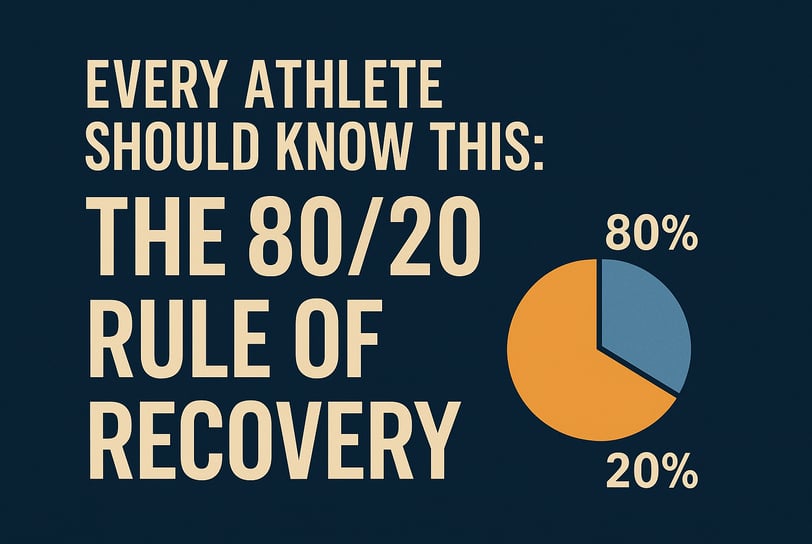The 80/20 Rule of Recovery: Maximize Results with Minimal Effort
Discover how the 80/20 Rule applies to athletic recovery. Learn which tools and habits deliver the biggest gains, and how to prioritize your recovery for peak performance without wasting time or energy.
5/26/20253 min read


Every Athlete Should Know This: The 80/20 Rule of Recovery
The Pareto Principle Meets Recovery
The 80/20 Rule—originally coined by economist Vilfredo Pareto—suggests that 80% of outcomes come from 20% of inputs. Applied to athletic recovery, this means a small subset of tools and habits deliver the majority of performance benefit WikipediaGlobal Perf Insights. As athletes, operating smart means pinpointing recovery methods that offer the biggest return with least time and energy investment.
Why You Need an 80/20 Recovery Strategy
Prioritize What Moves the Needle
Not all recovery tools are equal. Spending time foam rolling your calves for 15 minutes may be doing more for soreness than icing your wrist. The smart move? Identify the top 20% of strategies—like sleep quality, mobility drills, or percussive tools—that account for 80% of your bounceback.Prevent Burnout & Injury
Excessive or unfocused recovery work can backfire. You end up fatigued, confused, or with worse muscle soreness than when you started. Focused recovery ensures better performance gains without stacking fatigue.Work Smarter, Not Harder
Peak-performing athletes use 80% low-intensity training and 20% high-intensity output AthleticaKeep Going Run. The same applies off the field: spend 80% of your recovery time on daily sleep, nutrition, movement, and hydration, reserving 20% for targeted tools that amplify gains.
Step 1: Nail the Foundations (80% Recovery)
Before adding gadgets, your recovery toolbox needs three cornerstones:
Sleep Consistency: Aim for 7–9 hours nightly with regular sleep/wake times.
Nutrition & Hydration: Quality protein, healthy fats, electrolytes, and water fuel repair.
Gentle Movement: Light walks, yoga, or mobility drills help blood flow and flush metabolites.
A narrative review shows that these foundational elements—sleep, nutrition, and active recovery—form the base of true recovery effectiveness PMC.
Step 2: Amplify with the Vital 20%
Once your recovery essentials are in place, layer in high-impact tools that elevate your performance.
Product we recommend | Therabody Theragun Mini
This compact percussion massage gun pads strongly across athlete communities—and Simone Biles even swears by it for quick muscle relief People.com.
How to Use:
Apply to quads, calves, glutes, or shoulders post-workout
1–2 minutes per muscle group at a comfortable setting
Reuse as-needed for tension or pre-lift activation
A smart percussive tool can boost circulation and reduce soreness, giving your muscles a quicker reset for the next session Amazon.
Step 3: Targeted Mobility & Soft-Tissue Tools
Mobility and tissue tools belong in that vital 20%—they hit the right spots when you need them most.
Foam Rollers & Massage Sticks: Essential for chronic tightness—especially post-leg day.
Percussive & Manual Tools: Percussion massage (like Theragun) and massage sticks (like Chirp) are high ROI for localized recovery HealthAmazonNew York Magazine.
Product we recommend | Chirp RPM Rolling Percussive Massager
The Chirp RPM is a versatile hybrid—combining percussion and rolling into one hand-held device that works deep and wide Amazon.
How to Use:
Roll thighs, calves, and back with pressure + vibration
Great for those who “foam roll” but want speed/mobility in one product
Ideal for travel or post-game cooldown sessions
Step 4: Warm-Up Efficiency Tools
Prepping your body before workouts is another high-leverage move—especially when you're pressed for time.
Enter compression, heat/cold, and mobility tools.
Product we recommend | MOBILITY WALL Door-Mounted Foam Roller
This compact door-mounted roller gives you quick access to soft-tissue massage without cluttering your space Amazon.
How to Use:
Stand with back/IT band against roller, move side to side
Use 2–3 minutes per side before training or after a long day
Portable and simple for home, dorms, or apartments
Step 5: Make it a Routine (and Track It)
Daily: Sleep check-ins, hydration mapping, light movement, and stress awareness
3–4x/week: Add the Theragun Mini or Chirp RPM post-workout
Weekly: Use the Mobility Wall or foam roller session mixed with contrast flush (warm/cold)
Track progress with simple metrics: sleep quality, muscle soreness levels (1–10), mood/focus, and training readiness.
Why This Works
Nearly everything outside of sleep/hydration/movement delivers incremental gains. The high-value tools—like percussive massage and rolling—create faster muscle reset, improved circulation, and better functional range of motion.
Sports science shows that polarized (80/20) approaches outperform middle-ground training in endurance athletes Keep Going RunAthletica. The same holds for recovery: a few smart tools yield better gains than a dozen half-used gadgets.
Final Take: Focus on What Actually Moves the Needle
Building recovery “noise” is easy; building effective recovery isn’t. The 80/20 Rule guides you to prioritize foundational habits—sleep, hydration, movement—and then layer only the 20% of recovery tools that deliver 80% of the result. From targeted percussion with the Theragun Mini to hybrid rolling with the Chirp RPM, you’re aligning efficiency with performance and sustainability.
Pick one foundation and pair it with one smart tool this week. Track your sleep, muscle soreness, and workout readiness. Results will come faster—and your body will thank you for the focus and space. Let me know if you want a visual checklist or video script to walk followers through the process—happy to build that too.
FITNESS
Nutrition
WellnesS
info@movebetterco.com
© 2025. All rights reserved | Privacy Policy | Terms & Conditions